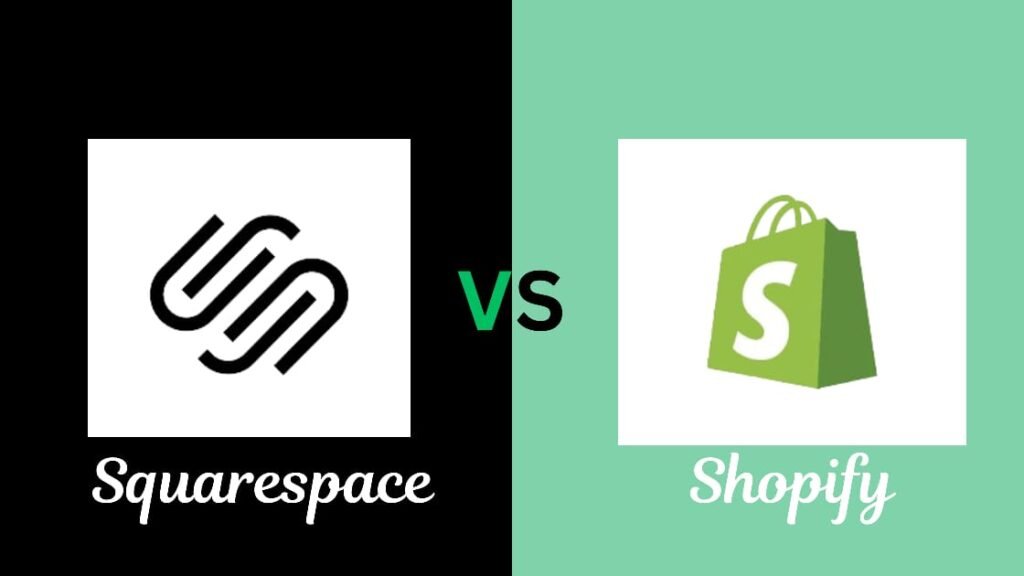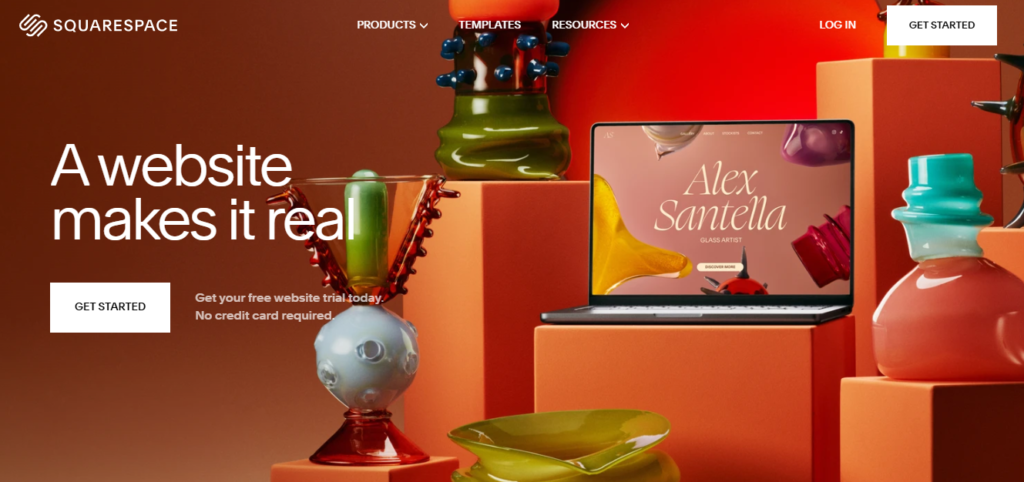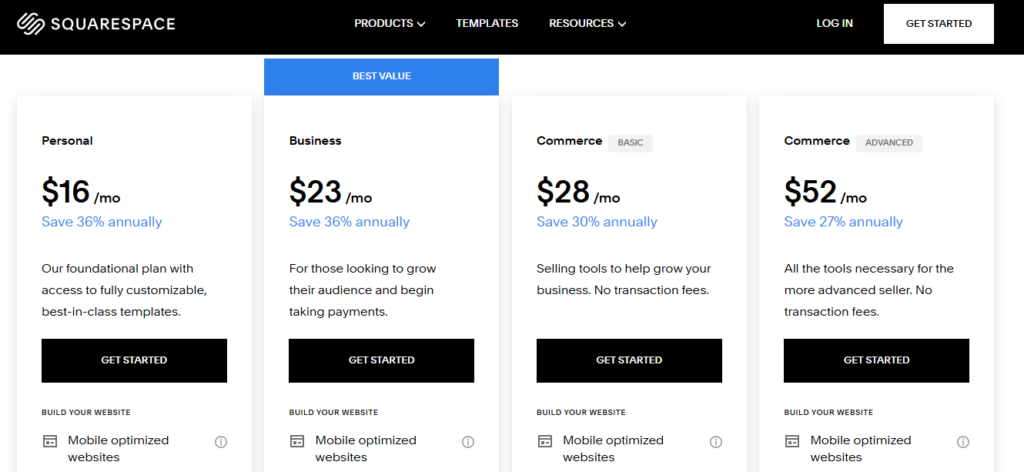By Abiola Gbolahan
Edited By Fredrick Oladipupo

Table of Contents
1. Introduction
Squarespace vs Shopify: E-commerce has completely changed the way businesses operate. With global online sales expected to hit record-breaking numbers in 2025, choosing the right platform to build and manage your online store has never been more important. The platform you choose will shape your store’s features, how customers interact with your site, and how well your business scales over time.
Two of the most popular platforms for creating a professional online presence are Squarespace and Shopify. Squarespace is well-known for its stylish design and user-friendly interface, while Shopify is a powerful, feature-rich option tailored for serious e-commerce entrepreneurs. Both have their strengths and cater to different business needs, making them top choices for business owners looking to establish their online presence.
In this blog, will break down the key differences between Squarespace and Shopify to help you figure out which one is the best fit for your business in 2025. Whether you’re a creative professional looking to showcase your portfolio, a small business owner expanding online, or an aspiring e-commerce entrepreneur, this comparison will give you the insights you need to make an informed choice and take the next step in your online journey.
2. Overview of Squarespace vs Shopify
When it comes to building a professional online presence, Squarespace and Shopify are two of the most well-known platforms. However, they cater to different audiences based on their core strengths and functionalities.
2.1 Squarespace

Squarespace is a user-friendly website builder celebrated for its design flexibility and visually stunning templates. It was founded by Anthony Casalena in 2003 and has grown into a trusted platform for creating elegant websites. It offers an intuitive drag-and-drop interface, making it an excellent choice for users with minimal technical skills. Squarespace’s focus is on esthetics, providing creatives, bloggers, and small businesses the tools to craft visually appealing websites.
- Ideal Users:
Squarespace is perfect for photographers, designers, writers, and small businesses that prioritize showcasing content or products with a clean, modern design. For those with minimal e-commerce needs, such as selling a few products or services, Squarespace delivers just the right balance of simplicity and functionality.
2.2 Shopify

Shopify is a dedicated e-commerce platform designed specifically for building and managing online stores. It was founded by Tobias Lütke, Daniel Weinand, and Scott Lake in 2006 and has since become one of the leading platforms for e-commerce. Unlike Squarespace, Shopify emphasizes robust tools for selling, inventory management, and payment processing, making it a preferred choice for businesses aiming to scale their e-commerce operations.
- Ideal Users:
Shopify is best suited for entrepreneurs and businesses that focus heavily on selling products online. It’s especially valuable for companies planning to manage large inventories, operate across multiple sales channels, or engage in drop-shipping.
3. Feature Comparison: Squarespace vs Shopify for Businesses
| Feature | Squarespace | Shopify |
|---|---|---|
| Website Design | Sleek, modern templates; drag-and-drop editor; limited coding flexibility. | Customizable themes (free and paid); advanced customization requires Liquid coding. |
| E-Commerce Capabilities | Basic tools (product pages, checkout, inventory); limited scalability. | Advanced tools (multi-channel selling, abandoned cart recovery, analytics); highly scalable. |
| Payment Gateways | Built-in Stripe and PayPal; no additional transaction fees. | Supports 100+ gateways; charges fees if not using Shopify Payments. |
| SEO & Marketing Tools | Basic SEO (meta titles, clean URLs); built-in email campaigns, social integrations. | Advanced SEO (structured data); marketing apps for email, SMS, and retargeting. |
| Third-Party Integrations | Limited app integrations; focuses on built-in tools. | Extensive app marketplace for custom functionalities like drop-shipping and analytics. |
4. Pricing and Value: Squarespace vs Shopify for Businesses
When considering an e-commerce platform, pricing plays a vital role in determining value for money. Squarespace and Shopify offer tiered pricing plans tailored to different user needs, but they cater to distinct audiences and budgets.

| Pricing Plan | Squarespace | Shopify |
|---|---|---|
| Entry-Level Plan | Personal: \$16/month (Save 36% annually) | Basic: \$32/month (Save with 3 months at \$1/month) |
| Mid-Tier Plan | Business: \$23/month (Save 36% annually) | Shopify: \$92/month |
| E-Commerce Basic Plan | Commerce Basic: \$28/month (Save 30% annually) | Advanced: \$399/month |
| Advanced Plan | Commerce Advanced: \$52/month (Save 27% annually) | Plus: Starting at \$2,300/month (3-year term) |
| Transaction Fees | No transaction fees in e-commerce plans | 2%, 1%, or 0.6% depending on plan level |
| Key Features | Mobile-optimized websites; best-in-class templates | Inventory management; localized global selling; 24/7 support |


Which is cheaper, Shopify or Squarespace?
Squarespace space offers a more cheaper plans in comparison to Shopify However, both platforms have free trials available, so you can explore their features and determine which one aligns with your needs before committing.
5. Ease of Use: Squarespace vs Shopify for Businesses
Squarespace is a great choice if you’re new to website building or aren’t very tech-savvy. It’s designed to be simple and user-friendly, with a drag-and-drop editor that makes creating beautiful websites a breeze—no coding experience needed. In addition, Squarespace offers sleek, pre-designed templates that let you build a professional-looking site quickly. It’s perfect for small business owners, creatives, or anyone who values ease, design, and simplicity over technical complexity.
Conversely, Shopify has more advanced tools for e-commerce. However, it can feel a bit overwhelming at first. While the dashboard itself is user-friendly, learning how to fully utilize all of Shopify’s features may take some time, especially if you want to customize your store or dive into advanced features.
Shopify uses a coding language called Liquid, which can add complexity for beginners. However, the good news is that Shopify provides plenty of guides, tutorials, and an extensive app marketplace to help users learn and grow into the platform. Once you get the hang of it, Shopify offers far more advanced e-commerce capabilities than simpler platforms.
6. Customer Support: Squarespace vs Shopify for Businesses
Squarespace offers 24/7 email and live chat support, along with an extensive knowledge base that provides answers to common questions and issues. This makes it easy for users to find guidance and resolve technical problems quickly. While Squarespace provides reliable assistance with free online webinar to refine your skills, Shopify goes a step further by offering 24/7 support through chat, phone, and email, ensuring multiple ways for users to get help whenever needed.
Additionally, Shopify boasts strong community forums and comprehensive guides, giving users access to a wealth of shared knowledge and resources. This makes Shopify’s support system more robust, especially for users who require hands-on troubleshooting and community input.
7. Pros and Cons: Squarespace vs Shopify for Businesses
When looking at Squarespace and Shopify, each has its own advantages and downsides. Squarespace is great for beginners and creatives due to its simple design, user-friendly interface, and affordability, especially for smaller websites or blogs.
Disadvantages of Squarespace compare to Shopify
However, it doesn’t scale well for large online stores and has fewer advanced e-commerce features. Shopify, on the other hand, is built for serious e-commerce with advanced tools, a vast app marketplace, and excellent scalability. Also, it can be more expensive and harder to learn for new users. Your choice will depend on your goals and experience level. Check the tables below to have a deep understanding of whats best for your businesses.
7.1 Squarespace
| Pros | Cons |
|---|---|
| Beautiful and Aesthetic Templates: Known for modern, clean, and visually appealing designs. Perfect for portfolios, personal blogs, and content-driven websites. | Limited Scalability for Large E-commerce: May struggle with supporting large product catalogs or handling high-volume sales efficiently. |
| Beginner-Friendly Interface: Easy-to-use drag-and-drop editor with a minimal learning curve, even for non-technical users. | Limited Third-Party App Integrations: Fewer options for app integrations compared to Shopify’s expansive marketplace. |
| Integrated Blogging Features: A strong focus on blogging tools, ideal for creators prioritizing content creation. | Fewer Payment Gateway Options: Lacks the variety of payment gateway integrations that Shopify offers globally. |
| Affordable for Small Websites: A cost-effective option for individuals or small business owners who want to build a simple online presence. | Advanced Features Are Limited: Lacks advanced e-commerce features and complex technical customization options. |
| Streamlined Website Management: Combines website building and e-commerce tools into one easy-to-navigate platform. |
7.2 Shopify
| Pros | Cons |
|---|---|
| Best-in-Class E-commerce Tools: Shopify offers advanced e-commerce tools like multi-channel selling, abandoned cart recovery, and detailed analytics. | Higher Cost: Shopify plans can become expensive, especially when scaling or using advanced features. |
| Vast App Marketplace: Shopify has a large marketplace with numerous apps that allow users to add custom features like dropshipping, advanced analytics, and more. | Less Focus on Non-E-commerce Content: Shopify’s main strength is e-commerce, meaning it’s less ideal for content-driven websites. |
| Powerful Payment Gateway Options: Supports 100+ payment gateways globally, allowing businesses to cater to a wide range of customers. | Steeper Learning Curve: Although powerful, Shopify has a more complex interface requiring time to master its features. |
| Highly Scalable Platform: Designed to support businesses of all sizes, including large enterprises with thousands of products. | Customization Requires Knowledge: Advanced customization relies on Shopify’s proprietary Liquid coding language, which has a learning curve. |
| Strong Customer Support: 24/7 support via email, live chat, and phone. It also offers an active community forum for additional assistance. | Transaction Fees: Shopify charges additional fees on transactions unless users utilize Shopify Payments. |
8. Who Should Choose What?
If your primary goal is to showcase creativity, such as building a portfolio, personal brand, or a small business website, Squarespace is your ideal choice. Its visually stunning templates and straightforward design tools cater perfectly to creatives, photographers, and bloggers looking for an elegant, content-focused platform.
On the flip side, Shopify is a powerhouse for serious e-commerce entrepreneurs. If you’re planning to run a dedicated online store, manage large inventories, or expand into multi-channel sales, Shopify’s robust e-commerce features, scalability, and vast app marketplace make it the superior option.
9. Squarespace vs Shopify: Real-World Examples
Real-world success stories highlight how businesses have utilized Squarespace and Shopify to meet their unique needs. From creative portfolios built on Squarespace to thriving e-commerce stores powered by Shopify, these examples demonstrate how the right platform can align with specific goals, helping brands achieve online success. By understanding why these businesses chose their platforms, you can gain clarity on which option might work best for your needs.
9.1 Squarespace
Squarespace has been used by various businesses across industries for its visually appealing templates and ease of customization. Notable examples include:
- HBO Documentary Films: Their website uses a minimalistic design powered by Squarespace’s Montauk template. This approach effectively highlights their films, showcasing the platform’s strength in delivering clean and impactful visuals.
- National Geographic Kids: They employ the Bedford template, creating an engaging and easy-to-navigate website that aligns well with their educational and visual content.
- Keanu Reeves’ Arch Motorcycle: This motorcycle brand leverages Squarespace’s Brine template to feature high-quality images and bold typography, emphasizing its sleek and high-performance products.
Other successful small businesses using Square-space include Ventura Ceramics, which employs professional imagery and minimal design to enhance product appeal, and Laurie, a solo entrepreneur’s wedding planning service that emphasizes emotional connection and trust through its layout.
9.2 Shopify
Shopify’s strength lies in empowering e-commerce businesses with robust features and scalability. Successful examples include:
- Allbirds: This sustainable shoe brand utilizes Shopify to create a seamless shopping experience. Its focus on storytelling and product highlights demonstrates Shopify’s adaptability to branding needs.
- Gymshark: Starting as a small fitness apparel store, Gymshark grew into a global brand using Shopify’s scalability. The platform supports their heavy traffic and advanced marketing needs, showcasing its ability to handle growth.
- Kylie Cosmetics: Kylie Jenner’s beauty brand leverages Shopify Plus to manage high-volume sales during product launches. The platform’s reliability during peak periods underlines its suitability for celebrity-driven brands.
9.3 Why These Platforms Work Well
- Squarespace is ideal for businesses that prioritize aesthetics and brand storytelling, such as creative industries, freelancers, and small service-based businesses.
- Shopify excels with its e-commerce functionalities, making it the go-to choice for product-driven brands that require scalability and marketing tools to thrive online.
10. Conclusion: Squarespace vs Shopify for Businesses
Is it better to use Squarespace or Shopify?
Choosing the right platform for your website or online store depends on your specific needs and goals. Squarespace and Shopify are both excellent in their respective areas but cater to different audiences.
Squarespace stands out as the go-to platform for creatives, small business owners, and personal brands who prioritize design and ease of use. Its modern templates and beginner-friendly interface make it ideal for building visually appealing websites with minimal effort. However, it may fall short when it comes to handling large-scale e-commerce operations or offering advanced customization.
On the other hand, Shopify is the preferred choice for businesses focused on robust e-commerce operations. Its advanced tools for inventory management, multi-channel selling, and seamless integrations make it ideal for scaling businesses. While it has a steeper learning curve and higher costs, its capabilities justify the investment for those aiming to grow their online stores.
Key Takeaways:
- Squarespace is more budget-friendly and works well for smaller websites with fewer products.
- Shopify justifies its higher cost by offering comprehensive e-commerce tools tailored for growth and scalability.
- Choose based on your priorities: affordability and simplicity (Squarespace) or advanced e-commerce features (Shopify).
The choice between Squarespace and Shopify comes down to your unique needs and priorities. Whether you’re a creative looking to showcase your portfolio or a business owner aiming to scale your online store, each platform has something valuable to offer. Test both platforms using their free trials to see which one feels like the perfect fit for your vision and goals. Remember, the right platform can make all the difference in creating a seamless online experience for you and your audience.
If you’re interested in exploring similar comparisons to make the best choices for your business or personal projects, check out these insightful blogs:
- “PayPal vs Stripe: Which is Best for Your Business?” Dive into a detailed breakdown of two leading payment platforms to find the one that matches your business needs.
- “ClickUp vs Monday.com: Which Project Management Tool Offers Better Value?” Uncover how these two project management platforms differ to suit various team and workflow needs.
- “Hootsuite vs Buffer: Which Social Media Management Tool is Best for 2025?” Learn how these platforms stack up for managing your social media strategies effectively.



Great information shared.. really enjoyed reading this post thank you author for sharing this post .. appreciated
I appreciate you sharing this blog post. Thanks Again. Cool.
I truly appreciate your technique of writing a blog. I added it to my bookmark site list and will
Pretty! This has been a really wonderful post. Many thanks for providing these details.
There is definately a lot to find out about this subject. I like all the points you made